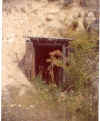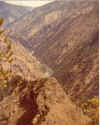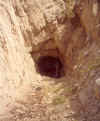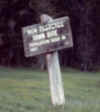Florence, Idaho County, Idaho
Photos at bottom contributed by: Penny Casey
|
Gold in northern Idaho was discovered by E. D. Pierce and company in 1860 while en route to the mines of present-day Montana with supplies. On the way, the men had to pass through the Nez Perce Indian Reservation near the Clearwater River. While they camped, the men looked for gold. Their discovery was near present-day Pierce, Idaho. The men returned to Walla Walla and reported their discovery. The intention, as usual, was to keep the gold discovery a secret so that only a few men would go into the country and do more prospecting. There was opposition to Pierce's desire to prospect gold on the reservation. But despite the opposition by a large group of white men, Pierce and his company of men went anyway. They used the Indians as guides and to help keep the peace between themselves and the rest of the tribe. But, as is the case in all of the previous gold discoveries, the news leaked out. The Nez Perce treaty was renegotiated to allow some whites to mine gold. However, the few whites became an onslaught as the word was passed about the new discoveries. By spring of 1861 hundreds of men were mining Canal Creek and the regions around the camps of Pierce and Oro Fino City. As spring passed into summer scores of men drifted south hoping to cash in on early discoveries at such places as Elk City. More gold was discovered at the present site of Florence by John J. Healy who arrived in September. He and a handful of other men quickly filed claims and reaped the rewards of being the first to find the precious metal. By October, the situation was quickly changing for the miners. Snow was falling and was more than a foot deep by mid-October. The lucky miners left by November and December and thereby avoided some of the devastation that followed due to severe winter weather. The winter of 1861-62 was one of the worst in the Pacific Northwest for some time. Deep snow clogged the passes making the transportation of supplies into the camps limited if not impossible. Sub-zero temperatures killed scores of men either traveling into the mines or trying to leave. If the extreme temperatures did not kill the ill-prepared men, starvation became their companion. Gold fever was so intense that many men did not take enough food and supplies with them. These were mostly veteran miners who probably figured that, like in past gold rushes, supplies would be forthcoming. Sadly, that was not the case for these unfortunate gold seekers. Men in the mines were not the only ones who suffered during this winter. Miners who had returned to Walla Walla to spend the winter did not find much solace there either. Firewood became so scarce that furniture and fence posts became fodder for fires as citizens strived to keep warm in poorly constructed houses. The extreme cold killed scores of people throughout the Pacific Northwest. Many cattle ranchers lost more than half of the stock due to range grasses being deep beneath the snow, while others lost all of their herds. When I was young we went to Florence every weekend to stay in our cabin. I rode every inch of road on my motorcycle, knew where every old mine was and went to them all. Oh, how I wish I had photos of them all! We also did lots of fishing in the dredge ponds and on Sand Creek. Now the road has changed once you get there and most of the old signs giving directions to the mines are gone. There isn't much left of any buildings in Florence now. A little bit of an old barn, a small section of the jail sits down in the trees (an old guy down on the Salmon River once showed us the door from the jail that he had kept for safe keeping), There is also a tiny bit of one of the "Brothels" still there. Mom always called it the Chinese Laundry, but after I grew up, I found out the true identity of it. I was talking about the "Laundry" one day and everyone in the family laughed at me, because they thought I knew the truth. I guess I was just gullible! There are still a few cabins that are owned by private individuals that have Patented Mining Claims.
|
Click on the thumbnail photos below to view some scenes from Florence.
If you use these photos for your own pleasure, please give credit to me, as I have worked very hard to put this website together!
|
Moose in Dredge Ponds 1995 |
Section of Jail at New Florence 1995 |
An old mine shaft 1995 |
Old Cabin 1995 |
|
M & M Mine, next to the cemetery road. 1995 (this name is a newer one) |
M & M Mine 1995 |
Cabin at Monarch Mine 1995 |
New Florence 1995 |
|
New Florence 1995 |
Powder Shed @ Scott Williams Cabin 1995 |
Scott Williams Cabin 1995 |
Scott Williams Cabin 1995 |
|
Old Tack Shed 1995 |
Outhouse with breeze-way at Waverly Mine 1979 |
Cabin at Waverly Mine 1979 |
Remains of old building at New Florence, being posted as WBS Mine. 1995 |
|
Cabin at Yakima Mine 1978 |
Cabin at Bullion Mine 1979 |
Old Shaft at Bullion Mine 1979 |
View of Wind River Bridge from Bullion Mine 1979 |
|
Newer Tunnel at Bullion Mine 1979 |
Actual Mine Cart from Old Shaft at Bullion Mine 1979 |
E.A. Parisot Grave at Bullion Mine (his son Raymond's ashes were spread on it in 1977. Picture taken 1979 |
New Florence sign (sorry it is blurry)1995 |






















